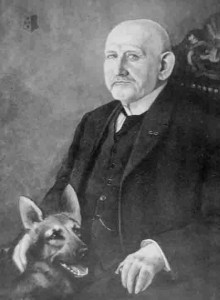
What is the difference between a German Shepherd and an Alsatian?
To the person with only a passing interest in dogs, the German Shepherd and the Alsatian are completely different breeds, despite looking very similar. They’re characterised by a domed forehead, a long square-ish muzzle and large, erect ears. They can come in lots of different colours, but the most familiar is black and tan, with a black ‘saddle’ across the back. There are other variations in colour, including all black, all white, blue, sable and liver.
According to The Kennel Club, sable and all black coats are perfectly acceptable; blue and liver are considered serious faults and all white is considered grounds for instant disqualification. This is because the white coat is much more visible if it is a guard dog, and it makes the animal harder to see if it is herding sheep or if it is snowing.
So what is the difference between the two? In fact, there’s none at all; the divergence in name came about as a result of the nationwide anti-German sentiment after World War I.
The breed is a relatively recent one, and its origins can be traced back to 1899. In an effort to standardise dog breeds in Germany, the Phylax Society was conceived in 1891. The venture was to be short lived, and ended after three years. However, it was successful in inspiring breeders to pursue standardisation independently.

Once such person was Max Von Stephanitz, who purchased a dog at a show and, naming it Horand, founded the Society for the German Shepherd Dog. Horand was named as the first German Shepherd and was noted on the society’s register.
Horand was the focus of many breeding drives, and fathered lots of pups with dogs with desirable traits who belonged to other members of the society across Germany. The Society for the German Shepherd dog succeeded in its goals mainly because of Von Stephanitz’s uncompromising vision and strong leadership; he is widely credited as creating the breed. Nowadays, such a task would be much easier with the availability of stud dog directories that offer a wide variety of dogs to complement a bitch’s weaknesses.
Bred to herd sheep, the English name ‘German Shepherd Dog’ is a direct translation of Deutscher Schäferhund. The breed’s intelligence, strength and loyalty soon found it in favour with the police and the military and it was first introduced to Britain in 1908. When The Kennel Club first accepted the breed for registration in 1919, 54 dogs were catalogued. Within seven years, their numbers had swelled to 8,000, with the likes of Rin Tin Tin popularising the breed.
The direct English translation of its name was used for the official breed registry, but at the end of World War I, it was thought that the inclusion of the word ‘German’ would harm its popularity. The Kennel Club renamed it the ‘Alsatian Wolf Dog’, later shortening it to just ‘Alsatian’. The name remained, until a campaign succeeded in persuading the Kennel Club to allow them to be registered as German Shepherds once again from 1977.
[…] Read Full Guide here August 9, 2010 Post Under Guides – Read More […]
The difference is that in the US, “Alsatian” is perceived as an exotic breed because no one has heard of it. I have a hard time keeping a straight face when they say, “Your dog looks very similar to a German Shepherd.”